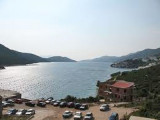
| Latitude | Longitude | |
| DMS | --- | --- |
| DM | --- | --- |
| DD | --- | --- |


Bora is the name of the cold and dry NE or N wind which blows with great strength and affects the Adriatic Sea in the cool season. It is much less frequent and generally much weaker in summer. This wind is felt strongly along both sides of the Adriatic and is especially violent where mountains fall steeply to the coast. Winds from the SE, S, and SW sometimes blow with great force and cause rough seas along the E side of the Adriatic Sea.
During spring and summer, moderate SE and N winds prevail. The former is accompanied by rain squalls and lasts generally two or three days. The N wind brings good weather and is encountered at night, sometimes beginning about 2 hours before sunrise, then ceasing at sunrise. During summer, SSW or WNW breezes are usual during daylight.
In autumn and winter, the bora is the most violent wind encountered, enduring often for two or three days. In the S part of the area it is more moderate than in the N part, where, in Tihi Kanal and its vicinity, it can achieve hurricane force. The sciroccoin winter is also strong and is accompanied by continuous rain. The libeccio is also encountered in severe force for a few hours, declining in velocity but continuing thereafter with mist and rain for long periods
The winds and weather in Velebitski Kanal and in Mali Kvarneric are those prevailing generally in the Gulf of Quarnaro. The high land of the NE shore of Velebitski Kanal produces violent bora squalls rendering navigation dangerous, especially since there are few tolerable anchorages. Small vessels usually hug the NE shore so that refuge can be obtained quickly in its coves and never remain underway at night during winter.
The bora blows violently in Mali Kvarneric but shelter can be found at times to leeward of some of the islands.The summer land breeze blows from the E and the sea breeze blows from the NW. Often in place of the sea breeze there are variable light airs and calms, most particularly in the S part of Mali Kvarneric. Calms are rare near Ostrvo Rab, where local variable winds are frequent.
Along this part of the coast, the bora blows with violence, especially close to the mainland, attaining its greatest force off Uvala Vrulja, at the E end of Bracki Kanal. The whole of Splitski Kanal and its entrance channels, as well as the S shore of Ostrvo Brac, are swept with strong bora winds. An indication of an arriving bora is the formation over the coastal peaks of white clouds, from which radiate small plumes.
In general, the bora blows more steadily and with less force in the vicinity of Ostrvo Vis than leeward of Ostrvo Hvar and the mainland. It is presaged a few hours by the formation, on the NE horizon, of white cumulus over a bank of dark compact clouds. When the sky becomes lead-colored, it indicates a violent bora accompanied by gusts of hurricane force, which last briefly. With this indication present, the first violent gusts from the N or NNE are preceded by a brief period of calm.
The sirocco blows fresh through the channels between the islands and brings fog. It is forecast by the formation of clouds on the mountain summits of the mainland and principal islands; frequently the atmosphere becomes so clear that vessels can sight Promontorio del Gargano. The scirocco and the libeccio cause high seas and strong ebb tidal currents near Rt Movarand on the W sides of the islands.
In summer, the night land breeze from the E, and the day breeze from the NW or W, becomes established near the mainland coast.
Along this coast the sirocco and the bora, which is forecast by the formation of masses of white clouds above or behind the mountains, are most prevalent during the autumn and winter months. The mistraele is the prevailing wind during the summer months and SW winds frequently attain considerable force and set up high seas. Land and sea breezes, alternating with great regularity, prevail during the summer months and frequently cause a rather heavy sea.
In general, the prevailing wind in the winter is from the NNW through N to NNE although SE and SW winds are frequent. During the summer the prevailing wind is from the WNW through N to NE, and SE and SW winds are rare.
In the winter along the NW coast of Pellg i Drinit the NE bora is severe and most frequent and alternates with the sirocco, a SE wind, which is more frequent in the autumn than in the winter. The sirocco is often accompanied by thick weather, making approach to the ports difficult.









